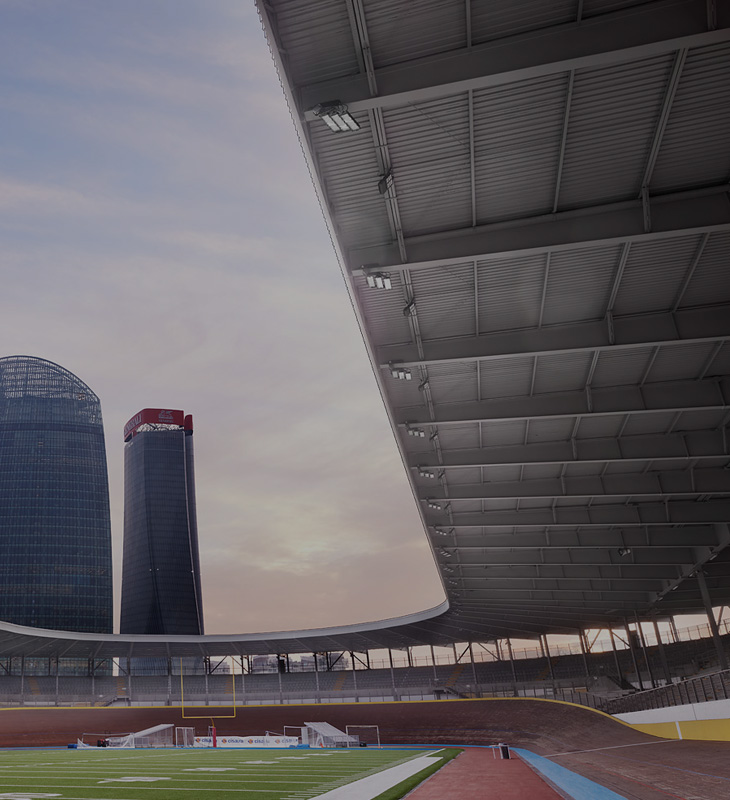
Correct lighting for the workplace
While each project should be analysed and evaluated individually, certain points are indispensable, regardless of the office type to be lit. Elements to be considered include:
- Type and place of light sources
This is where to start. Direct light sources must be understood as providing more intense, useful illumination in the work area, but risk leaving other areas that are not directly illuminated in shadow. On the other hand, exclusive use of indirect light sources – for example, that use light reflected from the ceiling to create diffused light over the entire area – limits differences in brightness, and while offering more even lighting, may not provide adequate lighting for the desks.
- Controlling lighting at the workstation
Today, the vast majority of offices have desks with computers where office workers spend most of their time. This makes it essential to study an element known as the Unified Glare Rating (UGR). This value is internationally recognised and agreed upon in a range from 0 to 30, identifying the glare conditions within an environment.
- The right balance between natural and artificial light
Obviously, having natural light must be ensured in offices and is indeed preferable to artificial lighting whenever possible. However, to prevent discomfort from overly intense light, shielding the sources of natural light is important under conditions of extreme outdoor brightness. It is also important to create an inviting environment by accounting for light variation during different times of day (particularly considering any work shifts) and, even more so, throughout the seasons.
- Energy efficiency
This element obviously does not affect productivity but is of great interest to any business owner. In recent times, enormous technological progress has been made with regard to efficiency and energy conservation: most mundanely by introduction of the LED lighting systems, but to a greater extent with the spread of remote programmable control units, which allow varying brightness depending on the time of day, the amount of daylight and the presence or absence of employees at their workstations.


Correct desk lighting
It is essential to distinguish between the types of workstation – for example, a desk with a computer (with VDT) requires less lighting than an art workstation, at reception or in a boardroom.
Anyone working at a computer needs even and diffuse lighting, not too aggressive and not too dim either; otherwise the tendency is to instinctively over-adjust the brightness of the monitor.
Artificial lighting in the workplace
The aim of good lighting in the workplace is to encourage productivity and concentration without eye strain. For this, you can’t just choose the most suitable and best performing lighting unit without, more importantly, having it placed in the right place within the working environment.
As we’ve seen, the ideal lighting for a work environment must be a blend of direct and indirect light, avoiding any excessive contrast between the zones receiving direct light and the other areas of the environment, to ensure good overall illumination of the space.
Lighting regulations for the workplace
The lighting requirements for indoor workplaces are regulated by the UNI EN 12464-1 standard, aimed at ensuring the comfort and visual performance of anyone with normal vision capabilities. By analysis of habitual visual tasks, this standard sets visual comfort requirements and provides guidance on the illumination levels, uniformity and maximum glare required for different visual tasks, including those involving the use of computers.
Apart from the lighting of the specific area, the standard describes the requirements for two other areas: the immediate surroundings and the background area.
For example: the standard states that desks equipped with computers must have a brightness of 500 lux on the work surface. For more complex activities and those that require greater precision (planning, graphics, design), the lighting intensity must be higher – between 750 and 1,000 lux.
Parameters to be considered
Certain well-defined parameters must be known for evaluation of a working environment’s illumination.
Luminous flux is the amount of light emitted by a certain light source or luminaire.
Luminous efficacy is the ratio of luminous flux to electrical power input (lm/W): this is the measure of the luminaire’s cost-effectiveness.
The quantity of light reaching the work area is defined as illuminance and is measured in lux (expressed in lumens/m², meaning the luminous flux emitted by a source hitting a surface area of one square metre).
Luminance, on the other hand, is used to express the actual intensity of a light beam emitted from a surface with extensive dimensions in the direction of the observer of the same light and is measured in cd/m².
These are the main elements – but not the only ones – to be taken into consideration when planning the lighting of an office or other workplace: the variables to be examined are diverse and not all easily foreseeable, so it is always best to rely on professionals such as architects and light designers for advice on lighting systems and the most appropriate solutions.
Discover the Related Range
Show other categories





































